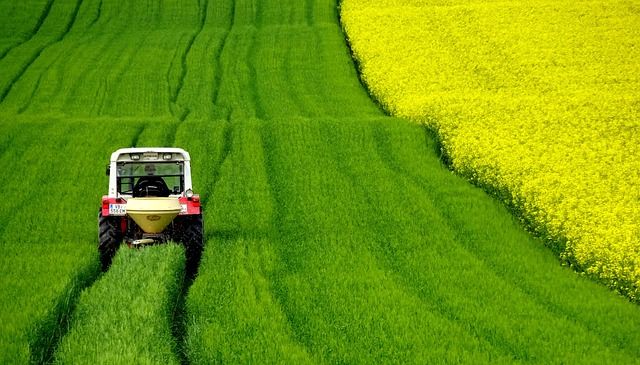Agriculture has become a policy battleground in the EU’s race to become carbon neutral. In Denmark, discussions are about to begin on a new “green tax reform” targeting agricultural production and food products. This law is critical to Denmark’s transition to a climate-neutral economy and must pave the way for a long-term transition to regenerative agriculture.

Photo: Pixabay
Agriculture has become a policy battleground in the EU’s race to become carbon neutral.
This is because, as most people are now aware, soils play an important role in carbon sequestration and agriculture is the main actor in soil management.
Several member states are in the process of rapidly enacting their own legislation to manage carbon emissions from agricultural production. This prompted massive protests by farmers across the bloc.
Farmers say the technological solutions available to reduce carbon emissions at scale are too expensive, and the government will penalize farmers by introducing better subsidies to help farmers make the green transition. They argue that we should encourage rather than give away.
Indeed, in a sector beset by extraordinarily tight profit margins and practices that resist change, there is little surplus cash to cover the costs of carbon-reducing technologies.
Denmark is proposing to introduce a “green tax reform” that would tax farmers based on the amount of greenhouse gases emitted by agricultural production on their land.
This impact is significant, with agricultural land accounting for more than 60 percent of Denmark’s total area. Denmark, along with Bangladesh, is the most cultivated country in the world.
Despite extensive climate action, farm emissions remain high
The foundations for the next green tax reform were laid with a broad political consensus in 2020 after Denmark’s agricultural sector failed to reduce greenhouse gas emissions over the past decade.
According to 2020 statistics from ecological NGO Okologisk Landsforning, Danish farms emit around 10.6 million tons of CO2 per year.
This burden represents 22.4% of the country’s total carbon emissions, compared to 15.6% a decade ago. That share increased as other sectors reduced their emissions.
What is Denmark’s CO2 tax?
The general idea is to make pollution more expensive for farmers, while the revenue from the tax is returned to the agricultural sector as a subsidy that makes green initiatives cheaper.
The CO2 tax, sometimes referred to as “CO2e” (for CO2 equivalent), covers several greenhouse gases commonly produced by agriculture.
Despite its name in taxes, CO2 is not the worst offender. For example, large amounts of methane are emitted by livestock and from fertilizers spread on fields.
According to the U.S. Environmental Protection Agency, methane is more than 28 times more effective at trapping heat in the atmosphere than carbon dioxide.
Emissions also come from low-lying soils. Lowland soils are typically drained and therefore emit both CO2 and nitrous oxide. Nitrous oxide is a gas more powerful than methane and up to 100 times more powerful than CO2.
According to Danmarks Naturfredningsforening, lowland soils make up just 7% of Denmark’s agricultural area, but account for around a third of the sector’s emissions.
Will it work?
Analysis by the Danish Climate Change Council in 2023 shows that a tax of DKK 750 per tonne of CO2 could reduce the sector’s 2030 emissions by around 45 percent compared to 1990 levels. It turns out that there is.
However, this still falls short of the 55-65% target agreed at the Folketingett conference in 2021, when agricultural emissions were last discussed.
The targets amount to reducing greenhouse gas emissions by 6.1 and 8 million tonnes, but the agreement actually only includes plans for a reduction of 1.9 million tonnes.
The remainder is expected to come from the development of new technologies such as feed additives that can reduce methane emissions.
Production taxes can encourage individual farmers to use these new technologies, encourage structural changes such as switching from animal-based to plant-based agriculture, and removing low-lying soils from distribution. is expected.
However, the proportion of Danish farms with negative net profits will increase from around 25% to 45%, according to the Danish Climate Change Council.
And further increases in tax rates will not incentivize farmers to reduce their emissions, as existing technological solutions, called “carbon abatement measures,” are not cost-attractive.
This means that innovation is the only way to ensure the sector’s long-term transition. The council argues that future green tax reforms could accelerate these changes.
This week is controversial
On February 21, an expert group commissioned by officials from the Danish government and the Danish Parliament releases its final report on green tax reform, including recommendations on how Danish agriculture can reduce emissions. I plan to.
The document will be handed over to Danish politicians who will discuss possible next steps and its importance in the European-wide debate before reaching an agreement.
A green consumption tax on supermarket products with high carbon costs is also part of the proposal.
Economists estimate that this will increase the price of meat and dairy products by 6%, DR said.
The 2021 agreement was careful to stress that the next reform needed to maintain “social balance” to avoid widening inequality, but it was a hot topic during the last election, with Mette Frederiksen in the debate famously commented as follows:
“A single mom with three kids who goes to soccer makes spaghetti meat sauce after practice. I don’t want to pay extra taxes on what I consider to be perfectly normal food.”
Professor Christian Conhoy, a climate and inequality researcher at Aalborg University, said that in the same way that revenue from taxes on agricultural production is passed back to farmers through subsidies, revenue from taxes on meat and dairy products is It claims that it can be reduced to Danes. as a “green check” or tax credit for low-income earners.
“Introducing a CO2 tax alone could widen economic inequality, with those at the bottom of the income pyramid taking charge of the green transition and adjusting their consumption, while wealthier Danes are able to live as usual. There is a certain gender,” Konshoji tells DR.
In any case, many experts argue that Danes should reduce their beef intake. A 2021 University of Copenhagen survey of 7,500 people in 21 countries found that 46% of Europeans had reduced their meat intake in the past 12 months.
Denmark’s figure was 37%, placing it at the bottom of the list for reducing meat intake.
Last year, Tax Minister Jeppe Bruce diplomatically responded to Mr Frederiksen’s meat sauce comments by saying: “We have to meet our climate targets, but we have to do it in an inclusive approach.” did.
renewable agriculture
Taxes on meat, dairy, and agriculture may challenge our collective habits and practices, but agriculture has great potential to participate in climate action.
Given the importance of soil for carbon storage, agriculture could be as much a tool to combat climate change as it is currently a major contributor to it.
A new generation of climate-friendly agriculture, called “regenerative agriculture,” can achieve this by actively supporting ecosystems, capturing carbon from the atmosphere, and creating healthier soils.
Several independent resources have already been introduced to support the agricultural sector. For example, Climate Farmers facilitates information exchange, measures data on the impact of sector transformation on soil, and develops financial support for farmers.
Whatever form Denmark’s Green Tax Reform Act takes, it must pave the way for a long-term transition to regenerative agriculture.
This is important legislation that sets the socio-economic playing field for a green future for Denmark and Europe.
